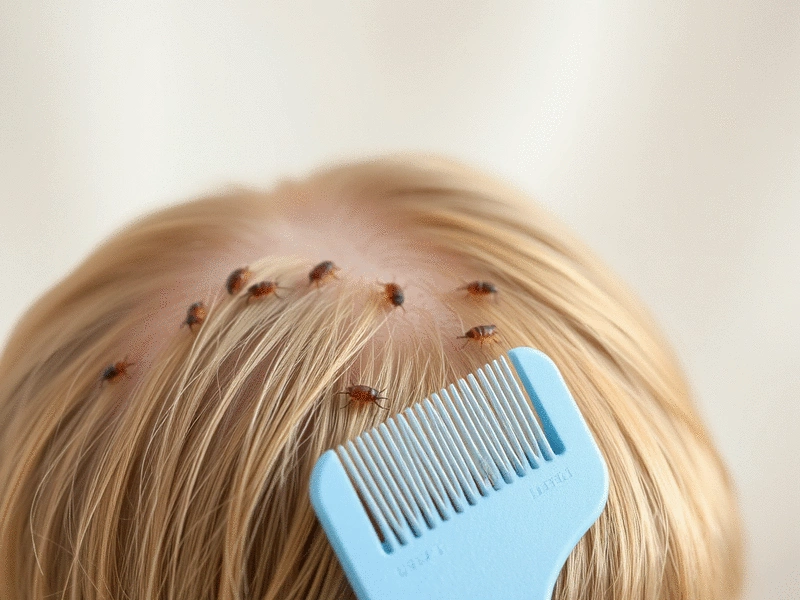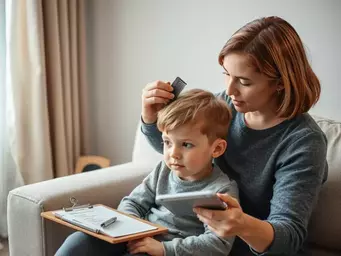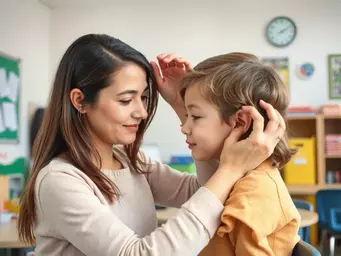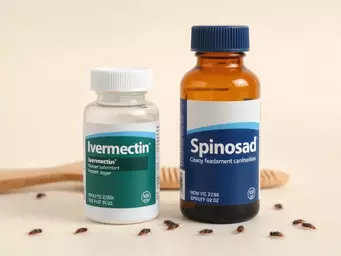How to Find Lice and Nits

What if a simple check could save your child from discomfort and help you avoid a household headache? Early detection of head lice is not just a precaution; it’s a proactive strategy that every parent should embrace. By knowing the signs and acting quickly, you can turn a potential crisis into a manageable situation.
What You Will Learn
- The importance of early lice detection in preventing infestation spread.
- Common signs to watch for, including persistent itching and nits in hair.
- Symptoms associated with head lice that may indicate an infestation.
- Steps to take immediately upon confirming the presence of lice.
- How to notify schools and manage emotional responses related to lice infestation.
- Overview of treatment options available, including over-the-counter and prescription medications.
Early Detection & Action Flow for Head Lice Management
This flow outlines the key stages from recognizing initial signs to implementing treatment and managing emotional responses effectively.
STAGE 1
Early Signs & Symptoms
- ✓ Persistent itching
- ✓ Crawling sensation
- ✓ Sleep disruption
STAGE 2
Confirmation & Impact
- ✓ Visible nits/lice
- ✓ Minimizes transmission
- ✓ Reduces treatment time
STAGE 3
Action & Communication
- ✓ Gather treatment supplies
- ✓ Notify school/caregivers
- ✓ Manage emotional responses
STAGE 4
Choose Treatment Path
- ✓ OTC vs. Prescription
- ✓ Natural remedies
- ✓ Consult pediatrician
Understanding the Importance of Early Lice Detection on Your Child’s Scalp
As a parent, spotting head lice early can make all the difference in effectively managing an infestation. At Lice Nits, we understand that the thought of lice invading your child’s scalp can be overwhelming. That’s why we emphasize the importance of early detection as a key factor in tackling this common issue head-on!
Detecting nits and live lice quickly not only helps in minimizing the spread within the household but also alleviates the stress that often accompanies this situation. The sooner we can address the issue, the more confident you’ll feel as a parent. Let’s dive into why early detection matters and what signs to watch for!
Why Detecting Nits and Live Lice Matters
Knowing whether your child has head lice is crucial. Early detection can prevent the problem from escalating and help you take swift action. Here are a few reasons why detection is essential:
- Minimizes Transmission: Identifying lice early reduces the risk of them spreading to other family members or classmates. Find more information on head lice from the Centers for Disease Control and Prevention (CDC).
- Reduces Treatment Time: The sooner you act, the less time and effort you'll spend on treatment.
- Less Anxiety: Quick detection can ease the worry many parents feel, knowing they can tackle the situation promptly.
By staying vigilant and checking regularly, you can empower yourself with the knowledge to manage head lice effectively!
Common Signs of Infestation to Look Out For
What should you look for when checking your child’s scalp? Here are some common signs that may indicate an infestation:
- Persistent itching, especially around the ears and nape of the neck.
- Red, irritated scalp from scratching.
- Small white eggs (nits) attached to hair strands.

If you notice any of these signs, it’s time to take a closer look. Early intervention is key to keeping your family lice-free!
Recognizing Symptoms Associated with Head Lice Infestation
Aside from physical signs, there are also symptoms that may indicate your child has lice. These symptoms can sometimes be mistaken for other conditions, so being aware is essential:
- Itching: Most commonly caused by the bites of lice.
- Feeling of something crawling in the hair: This sensation often leads to frequent scratching.
- Difficulty sleeping: Lice are more active at night, which can disrupt a child’s sleep.
If you observe these symptoms along with visible lice or nits, don’t hesitate! Taking action quickly can help you manage the situation and keep your child comfortable.
We Want to Hear From You!
Have you ever dealt with a lice infestation in your household? What strategies worked best for you? Share your experiences below, and let’s help each other navigate this common challenge!
What to Do After Confirming Lice Presence
Finding out that your child has lice can be shocking, but it's important to stay calm and take action. The first thing to do is to prepare for treatment. You want to ensure you have everything you need before diving in. This can help make the process smoother and less stressful for both you and your child!
- Gather the necessary treatment products, whether over-the-counter or prescription.
- Prepare an area for treatment, preferably where it’s easy to clean up afterward.
- Have a fine-tooth comb on hand for thorough removal of nits and lice.
- Set aside time for the treatment process, as it can take a while.
By taking these immediate steps, you’ll feel more prepared to tackle the lice situation efficiently. Remember, a little organization goes a long way!
Notifying Schools and Managing Emotional Responses
Once you’ve confirmed the presence of lice, it’s essential to notify your child's school. Many institutions have policies regarding head lice that require immediate communication. This helps protect other children and allows the school to take necessary precautions. The California Department of Public Health offers guidelines on managing head lice in school settings.
- Contact your child's teacher or school nurse to inform them of the situation.
- Follow any guidelines they provide for managing lice outbreaks.
- Consider discussing the situation with close friends or caregivers who interact with your child.

Addressing the emotional responses is just as important. It’s normal for both you and your child to feel worried or embarrassed. Reassuring your child that lice are common and nothing to be ashamed of can help ease their anxiety. Have you noticed how supportive conversations can make a difference? Sharing your experiences with other parents can also foster a sense of community!
Understanding Treatment Options: Over-the-Counter vs. Prescription Medication
When it comes to treating lice, you have a couple of options: over-the-counter treatments or prescription medications. Knowing the differences between these can help you choose what’s best for your family. For a comprehensive overview of treatment options, refer to the Mayo Clinic's guide on head lice diagnosis and treatment.
- Over-the-Counter Treatments: These include shampoos and lotions that contain insecticides designed to kill lice. They’re often effective but may require multiple applications.
- Prescription Medications: If over-the-counter options don’t work, a healthcare professional may prescribe stronger treatments that target lice more effectively.
- Natural Remedies: Many parents also explore natural treatments, such as essential oils. While these can be gentle, their effectiveness can vary.
Consider discussing these options with your pediatrician to determine the best course of action for your child's specific situation. Each child is unique, and finding the right solution can make all the difference!
Frequently Asked Questions About Head Lice
- Q: Why is early detection of head lice so important?
- A: Early detection minimizes the spread of head lice to other family members and classmates, reduces the time and effort required for treatment, and lessens parental anxiety by allowing for quicker action.
- Q: What are the common signs of a head lice infestation?
- A: Common signs include persistent itching, especially behind the ears and at the nape of the neck, a red and irritated scalp from scratching, and the visible presence of small white eggs (nits) attached to hair strands.
- Q: What symptoms might indicate my child has head lice?
- A: Beyond visible signs, symptoms can include intense itching caused by lice bites, a sensation of something crawling in the hair, and difficulty sleeping due to increased lice activity at night.
- Q: What should I do immediately after confirming my child has lice?
- A: Immediately gather necessary treatment products (OTC or prescription), prepare a designated treatment area, ensure you have a fine-tooth comb for nit removal, and set aside enough time for the treatment process.
- Q: Is it necessary to notify the school if my child has head lice?
- A: Yes, it is essential to notify your child's school or caregiver. Most institutions have policies requiring notification to help prevent further spread and allow the school to take necessary precautions.
Recap of Key Points
Here is a quick recap of the important points discussed in the article:
- Early Detection is Crucial: Spotting lice early minimizes transmission and reduces treatment time.
- Signs of Infestation: Look for persistent itching, red scalp, and small white eggs (nits) in your child's hair.
- Symptoms to Recognize: Symptoms include itching, a crawling sensation, and difficulty sleeping.
- Immediate Actions: Prepare treatment products, designate a treatment area, and use a fine-tooth comb for effective removal.
- Notify Schools: Inform your child's school to help manage the situation and protect other children.
- Treatment Options: Choose between over-the-counter treatments, prescription medications, or natural remedies based on effectiveness.
- Prevention Strategies: Regularly check your child’s hair, encourage tying back long hair, and maintain cleanliness at home.
Popular Posts
 Have you ever felt the panic that arises when you discover head lice on your child's scalp? Understa
Have you ever felt the panic that arises when you discover head lice on your child's scalp? Understa
 It's surprising how easily something as small as a head louse can disrupt an entire school community
It's surprising how easily something as small as a head louse can disrupt an entire school community
 What if the key to your child's comfort and well-being lies in understanding the aftercare process f
What if the key to your child's comfort and well-being lies in understanding the aftercare process f
 What if a single application could free your family from the stress of head lice? One-dose treatment
What if a single application could free your family from the stress of head lice? One-dose treatment
